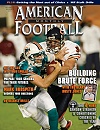Article CategoriesAFM Magazine
|
Samsonís Strength & Conditioning Coaches of the Year for 2010© More from this issueNFL Jones just completed his sixth full season with the Chicago Bears, the last three as Director of Physical Development. He spent the first three in Chicago as Strength and Conditioning Coordinator. The Bears surprised a number of critics this past fall and one of the reasons was that the team had very few serious injuries. Thatís quite an accomplishment when you consider the length of an NFL season Ė from late July to mid-January. Fo....The full article can only be seen by subscribers.
|
|
|||||||
| HOME |
MAGAZINE |
SUBSCRIBE | ONLINE COLUMNISTS | COACHING VIDEOS |
Copyright 2025, AmericanFootballMonthly.com
All Rights Reserved





